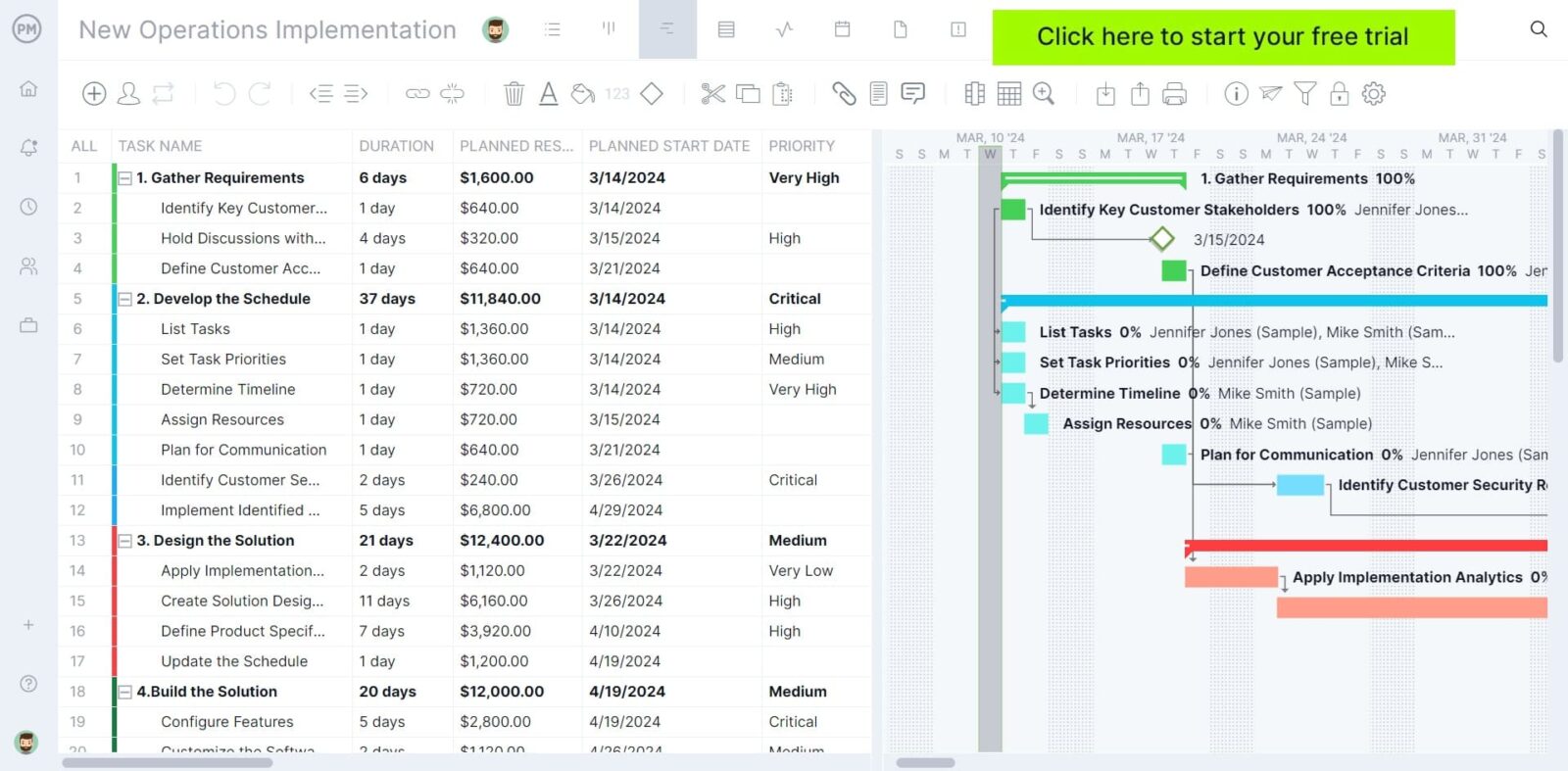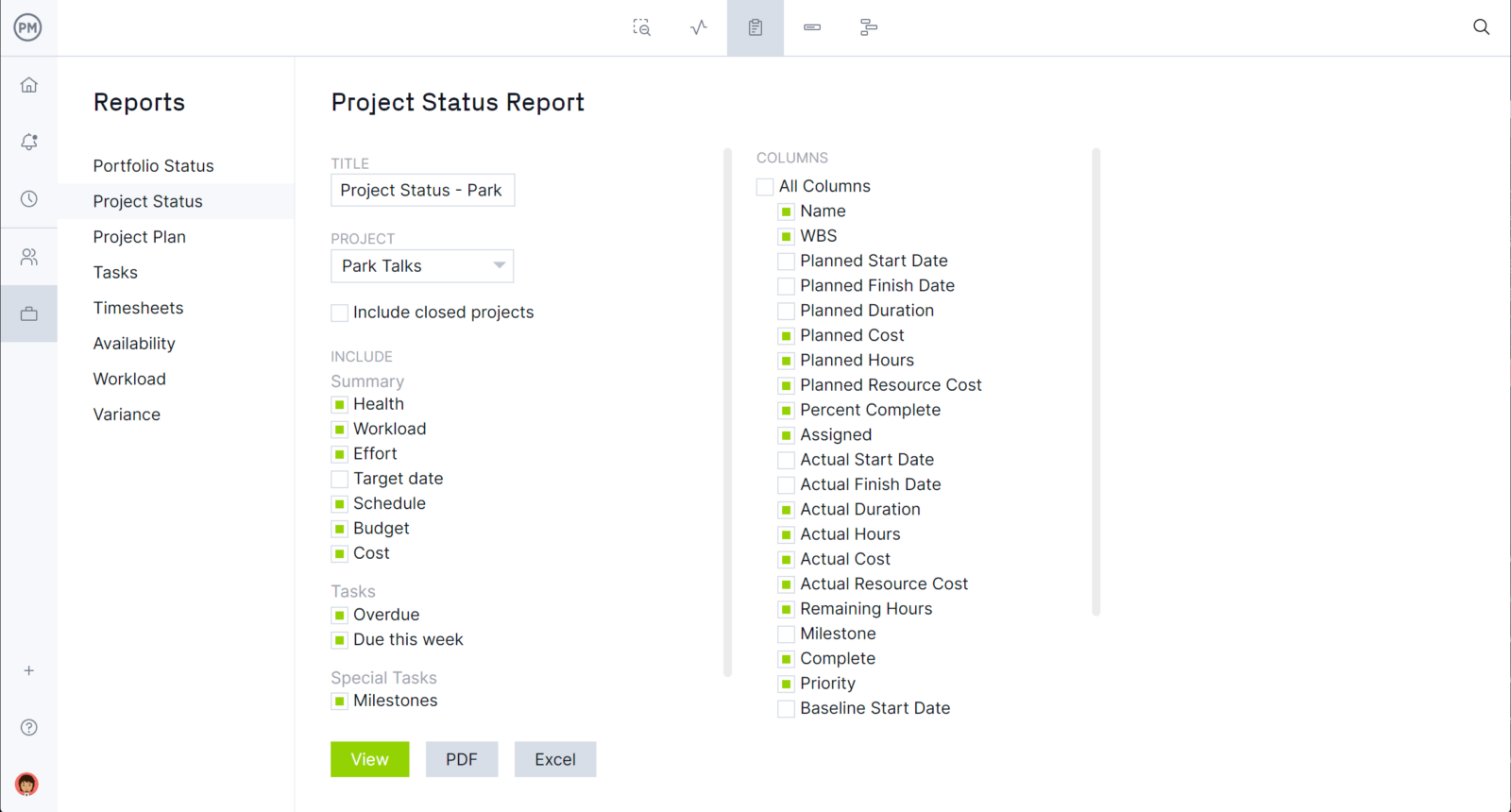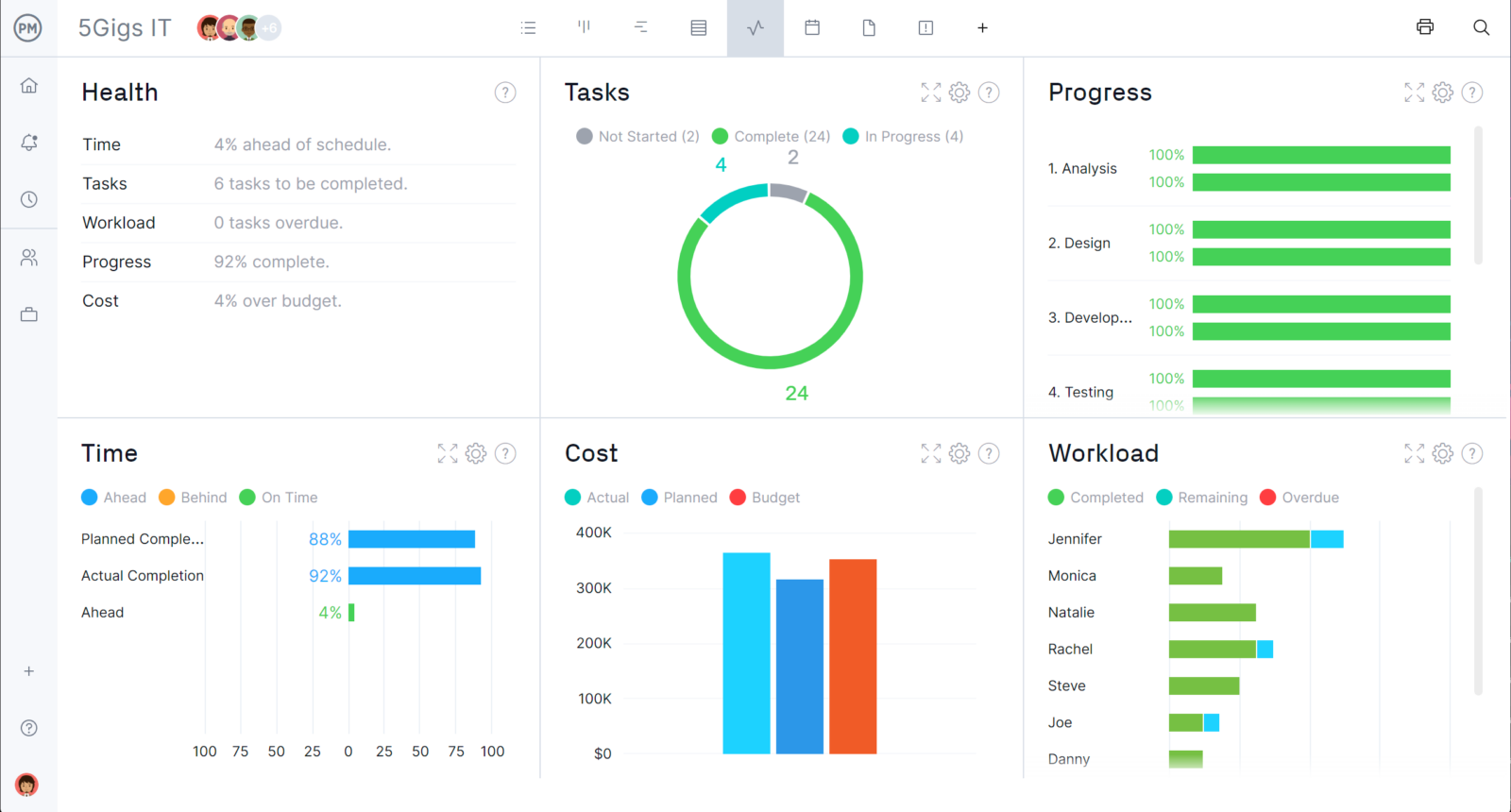It’s not uncommon for organizations to have more plans than they have funds. That creates a dilemma: how to spend their budget. A capital improvement plan can guide an organization when it’s trying to figure out which large projects or purchases in it should invest.
But what exactly is a capital improvement plan? How do you go about creating a capital improvement plan document? Are there benefits to developing a capital improvement plan? Can project management software facilitate this work? Before we answer all those questions, let’s start with a capital improvement definition.
What Is Capital Improvement?
Capital improvement is the process of making capital investments to improve the infrastructure of an organization, such as purchasing land, property, capital assets or renovating a building. These actions are outlined in a document known as a capital improvement plan. Besides businesses and non-profit organizations, governments also make capital improvement plans to decide what infrastructure projects to pursue.
Creating a long-term, substantial capital improvement plan is aided by project management software. ProjectManager is work and project management software that organizes your project, tasks and resources. Our interactive Gantt chart helps you coordinate your budget and schedule to manage and track substantial projects in real time. You can link dependencies to avoid delays, filter for the critical path and set a baseline to monitor your planned effort against your actual effort to keep on schedule. Get started with ProjectManager today for free.

What Is a Capital Improvement Plan?
Organizations use a capital improvement plan (CIP) to make smart budgeting decisions on which large projects or purchases to pursue. These decisions are based on the goals of the organization and what resources they can acquire.
This is a tool used more often by public entities such as local governments for major public expenditures. This includes purchasing major equipment, such as playground equipment, snowplows or computers. Capital improvement plans can also be used for acquiring land for a public purpose, such as a park, landfill or industrial site. Construction expansion or a major renovation of a public facility, such as a library or sewage treatment plan, are also targets of capital improvement plans. It can be used for related planning, engineering, design, appraisal or feasibility study costs.
The capital improvement plan is used to coordinate between community planning and fiscal management to determine the location, timing and financing of the capital improvement. This is usually a multi-year project, often four to six years. These are major but non-recurring physical expenditures.
A supplement to the organization’s larger strategic plan, the capital improvement plan must align with that strategy. The plan doesn’t only outline the capital projects and purchases, but also the timeline and funding options that’s separate from the organization’s annual budget, so it won’t include operational expenses. However, the capital improvement plan is aligned with the annual budget.
What Is a Capital Improvement Project?
A capital improvement project can be defined as a structural change that enhances the capabilities of a property or asset. This can mean different things for a business, a non-profit organization or a government. Here are some examples of capital improvement projects in each of these three scenarios.
- Public Capital Improvement Project Examples: A city government might execute projects to improve its infrastructure, such as building a new highway, renovating its water treatment facility or expanding the capacity of its electrical grid.
- Private Capital Improvement Project Examples: A private organization might execute capital improvement projects such as building a new warehouse, acquiring a fleet of vehicles or purchasing capital assets to meet the goals set in their strategic plan.
What Is a Capital Improvement Program?
In project management, a program is a set of related projects geared towards reaching a set of common goals, which is also true in capital improvement.
Capital Improvement Program Example
For example, if a manufacturer intends to increase its production capacity, he’ll need to execute a capital improvement program consisting of multiple capital improvement projects such as building a new production facility and access routes, along with capital investments such as purchasing machinery and equipment.
Liquidity & Working Capital Improvement
The working capital of an organization is a ratio that’s used to measure the liquidity of an organization. It can be easily calculated by dividing your current assets by your current liabilities.
This ratio helps you gauge the ability a business has to meet its expenses and financial obligations which is helpful when assessing its financial health. Working capital improvement is a series of actions that can be taken to increase the working capital of an organization, such as getting additional funds from investors, cutting down operating expenses and production costs, using trade credit insurance or shortening the operating cycle.
Features of a Capital Improvement Plan Document
There’s no standard format for putting together a capital improvement plan, so they might vary from one organization to another such as if they’re being created by a governmental office or a private company. Also, there are often requirements that differ from city to city and state to state. For example, you might have to get citizen approval before you can move forward with your plan. It’s best to look into the specific details as they pertain to wherever you plan on doing the work.
However, despite differences, common elements are shared with nearly all capital improvement plans. For example, you’ll need a list of all the capital projects, equipment and major studies related to the projects. These projects will then have to be ranked in some order, prioritizing them to have some alignment with the city’s strategic plan in which you’re working. A financing plan will have to be created, estimating the overall cost of each project. Plus, you need a timetable for the construction and completion of the projects, including milestones and critical rollout components.
A project justification is required to explain the need for the projects. Then you’ll have to classify, itemize and explain the project expenditures. This includes the estimated operation and maintenance cost of each project and the revenues, if any, from the projects.
Related: Free Estimate Template for Excel
Finally, you’ll have to outline the funding sources for the projects. This shows how the city will pay for the projects in your capital improvement plan. This outline should include debt management and whatever borrowing channels will be used, such as bank loans, bonds, taxes, appropriations, grants and so forth.
How to Create a Capital Improvement Plan
As noted, each jurisdiction has a different process and requirements for submitting a capital improvement plan. It’s critical to reach out to the city or state in which you’ll submit your capital improvement plan and get the details on how they do business.
There are, of course, relatively common steps to a capital improvement plan, which give you a basic idea of how to create one. They are as follows.
1. Submission
The first step is project submission. The local agencies and departments have to submit a list of the capital improvement projects that are collected in their capital improvement plan. This is why you want to rank the projects by priority.
You might be asked to provide a project description and justification (as detailed above). There will probably be a request for an estimate of the project costs, whatever ongoing operation and maintenance costs are associated with the project and the recommended funding sources.
2. Evaluation and Selection
Once the capital improvement plan is submitted, it will be chosen based on criteria that range from the desired service level standard to the demand for the project, depending on land, equipment and facility conditions.
Other factors at play include the number of residents the geographic area serves. Return on investment will also be looked at, as well as any cost savings or revenue generation. The sustainability of the project and how it rates in terms of energy efficiency improvements can also be looked at.
Economic, environmental, aesthetic or social impacts are taken into account. There are public health, safety and legal concerns to consider. The plan will be viewed as it aligns with community plans and policies, and the public or political support it has.
3. Financial Analysis
Historical data and projected local government revenues, expenditures and debt service will all be reviewed. This will allow the community to determine its ability to pay for the proposed projects. It will also lead to selecting the right financing tools for the project.
Related: Free Project Proposal Template
4. Plan Preparation
The capital improvement plan is drafted with a list of recommended projects by funding year. There will be scheduling details and financial sources included. Attachments, such as maps, photos, graphs, timelines and other illustrations, can be added to help flesh out the plan.
5. Review and Adoption
There will be a public review of the capital improvement plan which might lead to plan revisions. The governmental body will then vote on whether to adopt the capital improvement plan and budget. The capital improvement plan should be reviewed annually or at least every few years to ensure it’s updated for accuracy.
Benefits of Developing a Capital Improvement Plan
A capital improvement plan services the community in which the project will take place. For one, it ensures the timely repair and replacement of aging infrastructure. Residents, businesses and developers have a certain amount of certainty regarding the location and timing of these public investments.
The plan is also ideal for identifying the most economical means of financing improvement projects, which saves money. It also allows the public to participate in the budget and financing process and air any concerns or comments about it that they may harbor.
Having a capital improvement plan avoids poor planning which can be expensive and time-consuming. The plan is also helpful in avoiding a sharp increase in the tax rate, user fees and debt levels to cover unexpected capital improvements. It helps to match growth and development with the overall strategic plan of the area, balancing the need for public improvements with the community’s financial resources.
How ProjectManager Helps With Capital Improvement Plans
There are likely going to be multiple departments involved in the capital improvement plan process. It’s best if they’re all using the same system, which can act as a central hub for all the documentation. ProjectManager is project management software that helps you track workflows and budgets, set deadlines, monitor progress and report on the results. Our unlimited file storage provides a central hub for your documentation and our collaborative platform connects everyone no matter where or when they work.
Track and Share Data With Live Dashboards
Our live dashboard automatically calculates six project metrics, from cost to time and more. There’s no setup required as with inferior lightweight tools. It’s ready when you are, displaying results in easy-to-read graphs and charts that can be shared with stakeholders for a high-level view of progress and performance. This is also a great feature for keeping the public updated with project information. It builds trust through transparency and helps everyone live up to their responsibility.

Easy Reporting Features for Detailed Data
Reporting to stakeholders and having detailed records on the project helps keep everyone updated. With visibility into how the project is going, you can manage expectations and keep everyone happy. Our reports can be generated with one click and filtered to reflect information directly relevant to your project stakeholders. There are status and portfolio reports as well as reports on project health and more. They can all be easily printed or shared as PDF attachments.

As the project changes over the years, it’s easy to update the capital investment plan with our online tool, whether you’re in the office, at home or on the road. You’ll always be able to align your capital improvement plan with the larger strategic plan and annual budget. Automate workflows to keep teams focused on what matters and free them from busy work. Ensure quality with task approval settings that ensure no status is updated without the proper supervision. We have everything you need to make, manage and report on capital improvement plans.
Related Content
Making a capital improvement plan is very important, but is just one of many actions you should take when deciding how to allocate the financial resources of your organization. First, you should estimate your resource requirements, make a budget, get approval from stakeholders, among other things. We have created dozens of related blogs, templates and guides to help you master this process.
- Purchase Management: A How-To Guide with Best Practices
- Aligning Your Project to Business Strategy
- Capital Projects: Capital Planning, Budgeting and Funding
- Capital Budgeting: Definitions, Steps & Techniques
ProjectManager is award-winning work and project management software that connects hybrid teams for better collaboration. With one source of truth, teams and stakeholders are always working on the most current data, which is updated in real time. Join teams at NASA, Siemens and Nestle who use our tool to deliver success. Get started with ProjectManager today for free.


